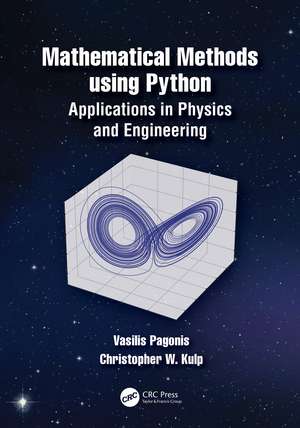Mathematical Methods using Python: Applications in Physics and Engineering
Autor Vasilis Pagonis, Christopher Wayne Kulpen Limba Engleză Hardback – 14 mai 2024
An introductory chapter gives students a crash course in Python programming and the most often used libraries (SymPy, NumPy, SciPy, Matplotlib). This is followed by chapters dedicated to differentiation, integration, vectors and multiple integration techniques. The next group of chapters covers complex numbers, matrices, vector analysis and vector spaces. Extensive chapters cover ordinary and partial differential equations, followed by chapters on nonlinear systems and on the analysis of experimental data using linear and nonlinear regression techniques, Fourier transforms, binomial and Gaussian distributions. The book is accompanied by a dedicated GitHub website, which contains all codes from the book in the form of ready to run Jupyter notebooks. A detailed solutions manual is also available for instructors using the textbook in their courses.
Key Features:
- A unique teaching approach which merges mathematical methods and the Python programming skills which physicists and engineering students need in their courses
- Uses examples and models from physical and engineering systems, to motivate the mathematics being taught
- Students learn to solve scientific problems in three different ways: traditional pen-and-paper methods, using scientific numerical techniques with NumPy and SciPy, and using Symbolic Python (SymPy).
Preț: 543.69 lei
Preț vechi: 679.61 lei
-20% Nou
Puncte Express: 816
Preț estimativ în valută:
104.03€ • 108.91$ • 86.08£
104.03€ • 108.91$ • 86.08£
Carte tipărită la comandă
Livrare economică 05-19 aprilie
Preluare comenzi: 021 569.72.76
Specificații
ISBN-13: 9781032278360
ISBN-10: 1032278366
Pagini: 504
Ilustrații: 252
Dimensiuni: 178 x 254 x 35 mm
Greutate: 1.09 kg
Ediția:1
Editura: CRC Press
Colecția CRC Press
Locul publicării:Boca Raton, United States
ISBN-10: 1032278366
Pagini: 504
Ilustrații: 252
Dimensiuni: 178 x 254 x 35 mm
Greutate: 1.09 kg
Ediția:1
Editura: CRC Press
Colecția CRC Press
Locul publicării:Boca Raton, United States
Public țintă
Postgraduate, Undergraduate Advanced, and Undergraduate CoreCuprins
Chapter 1: Introduction to Python. Chapter 2: Differentiation. Chapter 3: Integration. Chapter 4: Vectors. Chapter 5: Multiple Integrals. Chapter 6: Complex Numbers. Chapter 7: Matrices. Chapter 8: Vector Analysis. Chapter 9: Vector Spaces. Chapter 10: Ordinary Differential Equations. Chapter 11: Partial Differential Equations. Chapter 12: Analysis of Nonlinear Systems. Chapter 13: Analysis of Experimental Data. Further Reading and Additional Resources. Index.
Notă biografică
Vasilis Pagonis is Professor of Physics Emeritus at McDaniel College, Maryland, USA. His research area is applications of thermally and optically stimulated luminescence. He taught courses in mathematical physics, classical and quantum mechanics, analog and digital electronics and numerous general science courses. Dr. Pagonis’ resume lists more than 200 peer-reviewed publications in international journals. He is currently associate editor of the journal Radiation Measurements. He is co-author with Christopher Kulp of the undergraduate textbook “Classical Mechanics: a computational approach, with examples in Python and Mathematica” (CRC Press, 2020). He has also co-authored four graduate level textbooks in the field of luminescence dosimetry, and most recently published the book “Luminescence Signal analysis using Python” (Springer, 2022).
Christopher Kulp is the John P. Graham Teaching Professor of Physics at Lycoming College. He has been teaching undergraduate physics at all levels for 20 years. Dr. Kulp’s research focuses on modelling complex systems, time series analysis, and machine learning. He has published 30 peer-reviewed papers in international journals, many of which include student co-authors. He is also co-author of the undergraduate textbook “Classical Mechanics: a computational approach, with examples in Python and Mathematica” (CRC Press, 2020).
Christopher Kulp is the John P. Graham Teaching Professor of Physics at Lycoming College. He has been teaching undergraduate physics at all levels for 20 years. Dr. Kulp’s research focuses on modelling complex systems, time series analysis, and machine learning. He has published 30 peer-reviewed papers in international journals, many of which include student co-authors. He is also co-author of the undergraduate textbook “Classical Mechanics: a computational approach, with examples in Python and Mathematica” (CRC Press, 2020).
Descriere
This advanced undergraduate textbook presents a new approach to teaching mathematical methods for scientists and engineers. It provides a practical, pedagogical introduction to utilizing Python in Mathematical and Computational Methods courses.
